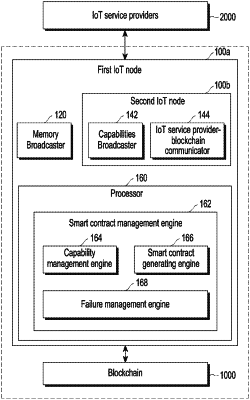| CPC H04W 72/51 (2023.01) [H04W 8/24 (2013.01); H04W 24/02 (2013.01); G16Y 30/10 (2020.01); H04L 41/50 (2013.01); H04L 67/12 (2013.01)] | 20 Claims |

|
1. A method for resource management by a first internet of things (IoT) node in a blockchain based IoT network, comprising:
receiving at least one capability information associated with at least one second IoT node from the blockchain based IoT network;
generating a smart contract to be executed between the first IoT node and the at least one second IoT node based on the at least one capability information, and at least one parameter associated with the first IoT node and the at least one second IoT node;
executing the smart contract with the at least one second IoT node; and
communicating with the at least one second IoT node based on the smart contract,
wherein said generating the smart contract comprises:
determining whether capabilities of the first IoT node and the at least one second IoT node match;
based on determining that the capabilities of the first IoT node and the at least one second IoT node do not match, determining whether a user manually want to match the capabilities of the first IoT node and the at least one second IoT node;
based on determining that the user manually wants to match capabilities of the first IoT node and the at least one second IoT node, determining matched capabilities which manually set by the user; and
generating the smart contract between the first IoT node and the at least one second IoT node based on the matched capabilities manually set by the user.
|